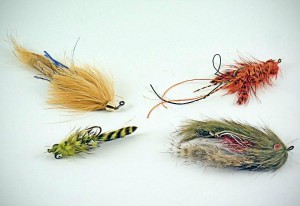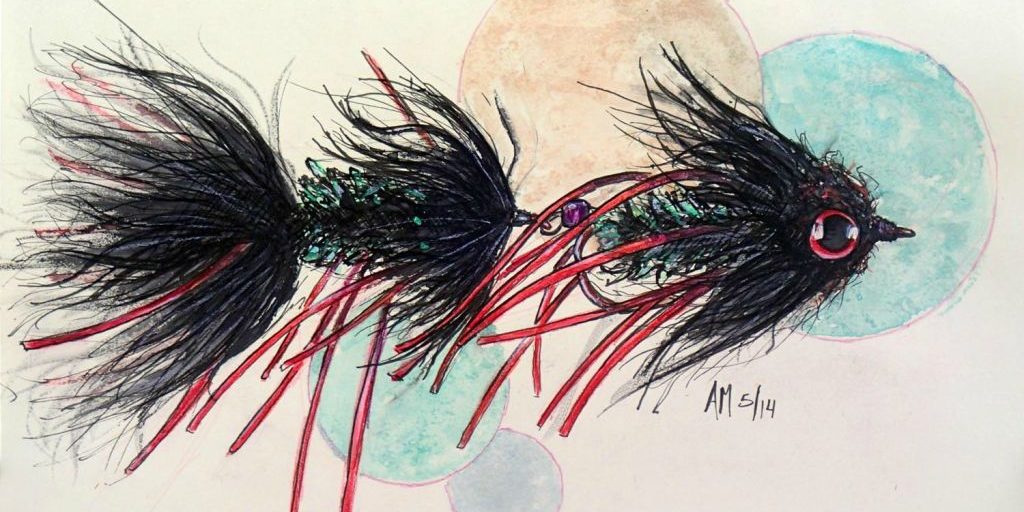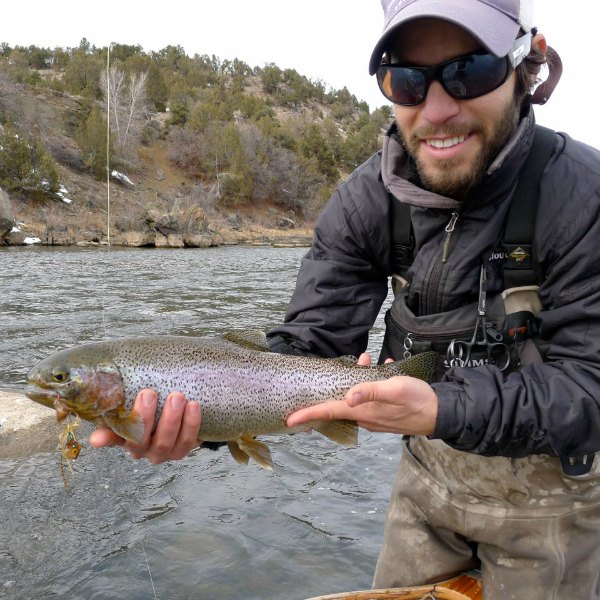Check out our recent video on setting up a streamer rod for Colorado above!
The Duranglers area is well on it’s way to our season of runoff. Warmer temps have increased the water flows…as well as piqued the primitive urge in fly fishers everywhere to get out and fish. The fish mojo is spreading like a wildfire and anglers everywhere are finding they want to hit the water! Daily we are seeing an increase in shop traffic from this “spring emergence of anglers”. When these stouthearted river warriors darken our shop threshold with their imposing visage, many pose with primordial curiosity: “What are they biting on?” Well after a few jokes exchanged, our shop staff inevitably leads the curious angler over to our streamer section and begins to point out the trout fare of the day. Halfway through explaining a favored streamer pattern, oftentimes our shop whiz is cut off with a second question: “That fly is huge, how do I fly fish with that?!” Well courageous trout poet, let me tell you how you fish with that fly…
The First Thing to Consider
The first thing you will want to consider is the rod you will be using. Ideally when fishing big streamers you will want to use a 6 or 7 fast action rod. However, we understand that having multiple fly rods is not realistically in everyone’s current budget. Anyone can make a streamer fish just as well with a 3 to 5 weight rod. Just keep in mind that casting a 6 inch articulated streamer pattern on a rod of this size can be frustrating and maybe even a little frightening. For smaller rods you may want to consider scaling down the size of your streamer.
The Most Important Thing to Consider
The most important thing to consider is that there really is no wrong way to fish a streamer. Really, you can’t go wrong with a streamer (as long as you have it in the water). Now granted, at times there are better ways to impart an action on a streamer than others; but there is no way that is “wrong”. For some beginning fly anglers, starting out with a streamer will assist with building confidence as they cannot do it wrong. One streamer on the end cuts out the need to worry about a complex nymph rig or getting a drag free drift (and seeing as there is no wrong way to fish a streamer you can even fish it like nymph with a drag free drift, but we will get there in a moment). Try out any number of techniques, or mix it up to get a different result. What techniques you may ask…?
Terminal Tackle to Consider
Let’s get this out of the way first: you do NOT want to be using your 5x dry fly and nymph leader and tippet with a streamer. That is a good way to loose flies quickly. You are going to need something a little more stout. Now a 2x or 3x leader will work well, but you have a few other options. The first is taking your 5x leader, cutting it back to where it is thicker (around 4-6 foot of leader) and tying in a foot section of 2x tippet or ten pound Maxima. Maxima is wonderful. It does not have the poundage rating of tippet, but works better with the heavy shock that comes with a fish taking a streamer. The second option is to just create your own leader using Maxima. Tie a 2 foot section of 20 pound Maxima to your line, tie in another 1 to 2 foot section of 10 pound Maxima, and you are set to rock those trout.
Techniques to Consider
Here is a handful of techniques to try out with you soon to be streamer obsession:
Swing it.
Swinging a streamer (or any fly) may be the oldest trick in the book; literally. People have been swinging flies through river currents for hundreds (maybe thousands) of years. The technique is simple. Cast across the current or downstream and across the current, make an upstream mend to get your fly pointing upstream (an upstream mend is a good idea, but since there is no wrong way to fish a streamer, try going without the mend), and let the river current do all the work for you. Your line will be pulled by the current through the area you are fishing towards the shore closest to the one you are standing. You can then recast your fly and swing again, or pull the fly back to you by using your non casting hand to pull the fly line through your rod thus pulling your fly towards you. This is called “stripping” your line…
Strip It
Stripping a streamer can be done many different ways. Fast, slow, jerky, smooth, quick with a long pause, slow with a short pause; use your creativity. Again, you can strip the fly towards you after you let it swing through the current. However, the most universal streamer technique is casting it down and across the current (like the swing) and then stripping it back to you as it swings. Try different speeds and actions to find out what the fish want. A good rule of thumb is: the colder the water, the slower the retrieve while the warmer the water, the faster the retrieve. Another way to present a stripped streamer is to cast it UP and across. Casting a fly upstream also gives it more time to sink to a deeper depth before you begin to strip it. This is also handy when you want to dead drift your streamer…
Drift It
If you are an absolute beginning fly fisherman, you may have never heard the term “dead drift”. Dead drifting is essentially drifting a fly through the river at exactly the same speed as the current. It may be gruesome, but think of a dead body floating down the river. That body is not swimming all over the place….but I digress. If you are an experienced fly fisherman, you may or may not have dead drifted a streamer like it was a large nymph. This technique works especially well when all other techniques are not producing fish. Trout may take your streamer as an injured or dead fish, sculpin, leech, stonefly, etc, and be unable to pass up an easy feast. A twist on this technique is to impart a little (or a lot) of action mimicking a injured and struggling baitfish. With the proper amount of weight, you could even be mimicking a swimming/escaping sculpin or crayfish with a jigging action…

Meat Whistle, Near Nuff Crayfish, Near Nuff Sculpin, and The One Sculpin. All great flies for jigging and stripping.
Jig It
Jigging a fly (yes much like a lure) is a technique not often utilized; but here on the Animas River can and does produce trout when nothing else seems to be working. The whole river is loaded with sculpin and the lower sections have a fair amount of crayfish. This technique works best with a streamer that fishes hook upwards to avoid snags, but works well with any heavily weighted streamer (my favorite patterns for jigging a fly are Bennett’s Lunch Money, Sculpinator Sculpin, Meat Whistle, The One Sculpin, and El Sculpito Streamer). Again, try different variations on this techque; however my favorite way is to cast upstream and use a short line technique much like high stick nymphing. With a little practice, you will be able to feel your heavily weighted fly bouncing off of the river bottom as it drifts downstream. Impart short twitches by “jigging” the rod tip which will mimic a swimming crayfish or a foraging sculpin. Most often a fish will take as the fly is dropping back down to the bottom after you have jigged it. You will go for the next jig and feel as if you have snagged the bottom…keep you line tight because that snag may just take off. Again, none of this is gospel. Try mixing and matching these techniques to get a result that produces fish.
Final Thoughts
- -Again, there is no wrong way to fish a streamer, open your mind…maaannnn….
- -Throw 10 and 2 out the window. Casting a streamer is different from casting a size 18 Adams. It may take a moment to get the rhythm of the cast…but all you really need to do is get the fly out there. It does not have to be pretty.
- -Fish to where you you think a trout lives…and then fish it to somewhere you are not sure. This may surprise you.
- -If you are fishing high water; fish tend to hold towards the bank; so fish the bank! You may not even need to wade in. Fishing from a raft or drift boat makes this much easier.
- -If you are a beginning streamer angler KEEP YOU ROD TIP DOWN! Keep the rod tip in the water if you need help remembering. This will greatly improve your hook up success.
- -STRIP SET. Much like our technique of stripping to impart some movement on the fly, you can also strip your line after a fish takes to set the hook. With streamers (hopefully you are using heavier tippet right?) a strip set will do two things:
- It will set that big ole hook properly in the fishes mouth or jaw.
- Should you miss actually setting the hook, it will still keep the fly in the fish’s zone and the fish may take another swipe at it. If a fish does hit and you miss the set, STOP EVERYTHING. Let your fly dead drift as if the fish just broke it’s back. Often times trout will strike a smaller fish to injur and cripple it only to move downstream to eat it as it drifts by. Whatever you do, DON’T lift up your rod to set the hook. Keeping your rod tip in the water will help with this.
- Finally, make the fly look alive. Do whatever it takes to make it look like it is alive and trying to get away from something.
And that is all! Hopefully these techniques will turn you from a pure minded dry fly warrior of light to a mainlining streamer junkie marauder.










great info, just curious tieing that Maxima leader, it sound like it’s only 3 feet long is that correct??
Hey Capt Bob, that is correct. We tend to fish shorter leaders for streamers as trout only have a moment to make a decision to eat or not. A short leader is not going to spook aggressive fish…if a fish is spooky a large streamer slapping the water will spook him anyway. Depending on the situation, you may want to lengthen up that leader a bit but we don’t usually ever fish a streamer leader longer than 5-6 feet (if you are trying to fish a lake pretty deep then you may want to use a longer tapered leader).
The other benefit to a short leader is having a good fly turnover with using straight Maxima. A 3-4 foot leader will cast better than a 7-9 foot Maxima leader.
Thanks for the question!
-Andy
What size water gremlin slip sinker.
1/16 ounce found here:
https://duranglers.com/product/water-gremlin-bullethead-sinker-/
Thank you!
Andy
Andy,
Watched your Streamer outfit setup video. That’s like drinking thru a fire hose! Looks like I’ll have to add a 6 weight rod to my wish list.
Hopefully, I can start learning to streamer fish with the 8 wt. I”m ready to build. Now I’m really pumped to tie some streamers! Would the Fly Tying Nights be a good place to do that? Do you come to those?
Dave
Hey Dave,
Yep, the fly tying nights would be a good place to tie streamers for yourself! Although it really isn’t an instruction night per se, there is still a lot to be learned from everyone else there! I do come to the tying nights, you should stop by if you can!
Andy